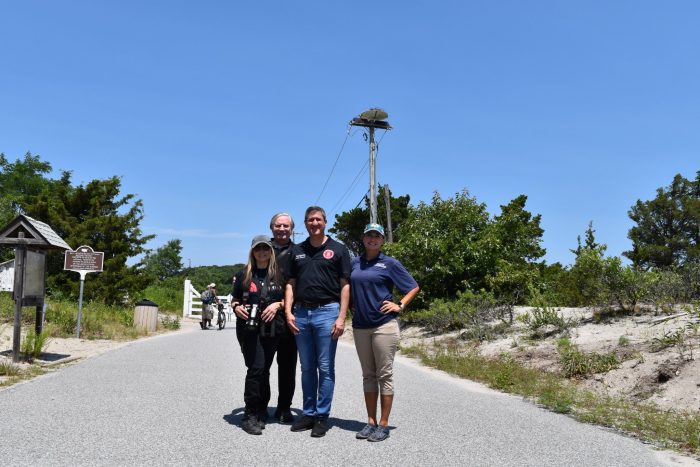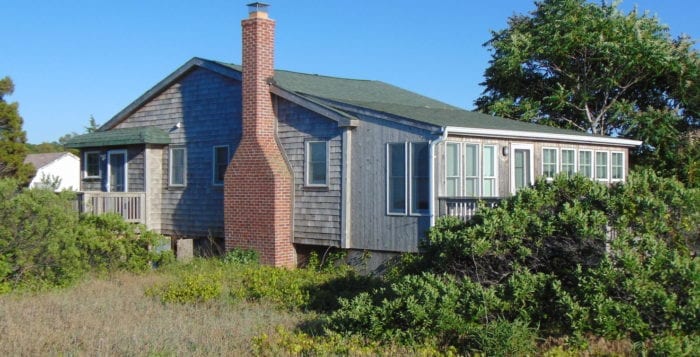By Mallie Jane Kim
Brookhaven Town officials unveiled a new historical sign at West Meadow Beach July 19, to mark the location of a summer beach community of bungalows that was removed in 2005.
The seasonal community, built along Trustees Road, had a contentious history, yet for those who enjoyed access, the string of nearly 100 beach bungalows was a place of rich memory of summer beach life.
“If you don’t tell the history, you lose it,” said Barbara Russell, Brookhaven’s town historian, who headed up the application to the Syracuse-based William G. Pomeroy Foundation, which granted the sign. Russell said growing up, she knew cottage owners and spent time visiting the unique community.
“My grandparents, my parents, me and my children have wonderful memories of the cottages here,” she said. “My six grandchildren absolutely never knew them.”
The new marker, which sits near the entrance of what is now the Trustees Road walking trail, reads, “West Meadow beach summer colony, private cottages built here on town-owned leased land starting in 1905. All but four of 93 cottages razed in 2005.”
Some area residents who remember the divisiveness of the private cottages, especially in the last few years before most of them were razed, question the move.
“Why memorialize the cottages?” wondered Setauket resident George Hoffman, who worked for the Town of Brookhaven during those last years, and currently sits on the West Meadow Beach Advisory Committee. “It was a very contentious thing.”
One concern is that the brief, neutral wording may gloss over the whole story.
“I hope that this new sign — that doesn’t say much — does not cause us to forget that during the almost century-long cottage era, most of the people of Brookhaven Town were denied access to their own public land, which was leased to a favored few,” said Suffolk County Legislator Steve Englebright (D-Setauket).
The sign that previously marked the spot simply acknowledged that the “West Meadow Beach Cottages Historic District” was added to the National Register of Historic Places in 2004 — an unsuccessful last-minute effort to save the bungalows, which were already scheduled for demolition by then.
The cottages started as tent platforms the town rented out, including to people fleeing the city due to the Spanish flu pandemic of 1918-19, according to documents on file with the U.S. Department of the Interior. Lessors were later allowed to build structures on the lots, which they rented originally for $10-20 per year.
In the intervening years, there were questions of whether the leases were given out as political favors or in sweetheart deals to the well-connected, and the fact that private cottages were built on public parkland led to multiple lawsuits and appeals over decades, culminating in their ultimate removal.
After a judge ruled in favor of removing the cottages in the late 1990s, Englebright, then a state assemblyman, authored legislation that solidified the timing of removal — allowing cottage residents to finish a prearranged lease term, and for the town to use that lease money to fund the removal of the structures and restoration of the parkland. He said his local office had to install security cameras and a panic button because of threats and harassment over the issue.
He added that over the years, he heard stories of cottage owners themselves being hostile to residents trying to access the area.
Englebright himself remembers an incident from his 20s, before he got involved in politics, when he was out on the water in a dinghy and a surprise summer storm drove him into that stretch of West Meadow Beach. He said a cottage owner with two German Shepherds confronted him.
“He said, ‘Get the hell off my beach,’” Englebright recalled, adding that after he apologized, the man repeated his demands and sent his dogs after him. “They drove me into the water, which was still breaking waves over my boat and myself.”
He added, “That was before I learned that, in fact, it wasn’t his beach.”
Englebright suggested a second sign could tell a more complete version of events. “The way in which courageous civic advocacy ultimately created the magnificent park that we have today deserves to be remembered,” he said.
Town historian Russell doesn’t see the neutral sign wording as a problem.
“You can’t ever tell the whole history in five lines,” Russell acknowledged, adding that she hopes long-stalled plans to restore one of the remaining cottages will result in an education center that can tell a more complete story. Or, perhaps one of the local historical organizations could take up the task. The Pomeroy sign, she said, is to pique interest.
“This is just to get your attention and say, ‘Oh, there were cottages here once,’” she said. “There was a whole summer community here once.”











